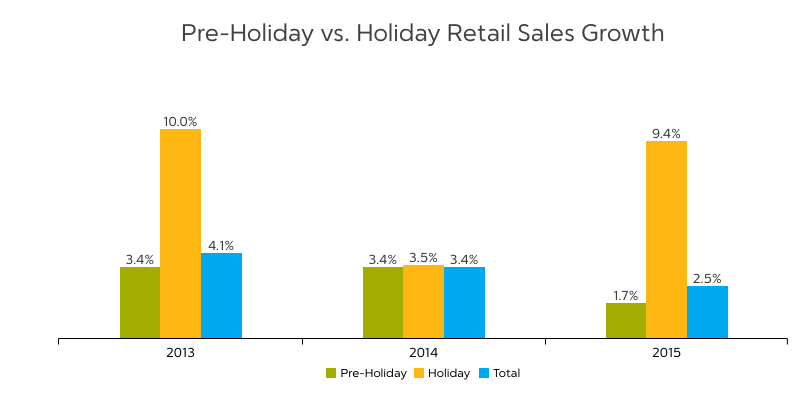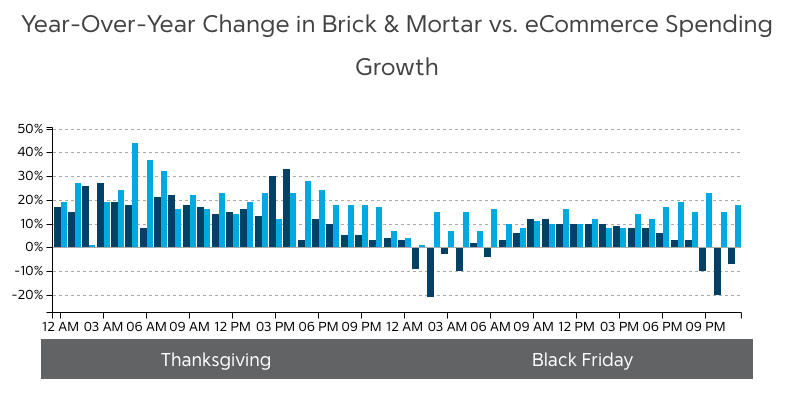
A lot of data is tossed around during the holiday season. And a lot of myths are, too.
That’s where First Data is attempting to step in to give some credibility to just what the holiday shopping season has looked like so far. Using the First Data SpendTrend: Thanksgiving Holiday Shopping Spend Analysis, it can be concluded that holiday shopping is moving ahead at full speed.
And Thanksgiving and Black Friday provided a sturdy foundation.
First Data’s analysis includes card-based forms of payments for more than 820,000 merchant locations across the U.S. Of those, more that 600,000 merchants were used to perform what First Data calls intra-day hourly analysis for both of the first two holiday shopping days.

Source: First Data
What the data show is, despite some industry projections that spending growth would be down, retail spending growth on Thanksgiving/Black Friday jumped 9.4 percent from last year. While the perception is that because retailers were extending their sales, or starting them early, that those days would be more evenly dispersed in November.
That didn’t end up being the case, First Data’s research shows. Black Friday retail spending increased 4.9 percent alone, which is up from last year’s growth of 3.5 percent two-day spend. Overall spend on Thanksgiving Day grew 14.3 percent; Black Friday overall spend grew 8.2 percent.
“We see this is a very good, very healthy start to the season,” Krish Mantripragada, SVP of Information & Analytics Solutions, told PYMNTS in an interview. He later noted that: “Thursday and Friday, contrary to other belief, continue to dominate as the two main days for the holiday period.”

Source: First Data
Interestingly enough, spending on Thanksgiving was the strongest during the morning hours, which caused it to taper off later in the day, the data also show. Spikes in the day were around 5-6 a.m. Thanksgiving morning and then shortly after 4 p.m.
Black Friday spending remained relatively consistent during the day in terms of spending, but the strongest period was just before the middle of the day.
One tradition that was tossed aside this year was shoppers arriving at midnight to catch those first sales. That trend didn’t appear in the data, as the early morning hours were slow in terms of spend — and down in most cases when compared to last year. Overall, online sales grew 19.8 percent on Thursday and 12.1 percent on Friday.

Source: First Data
Even brick-and-mortar retail saw a trend in more spending, as sales grew 8.2 percent on Thanksgiving morning. This could also be attributed to more retailers opening their doors earlier. Brick-and-mortar grew spend 12.2 percent on Thursday, and 7.2 percent on Friday.
Online spending, of course, was the shining star this holiday season. And First Data’s research points to that. Online sales (as a percentage of total spend) grew to 18.3 percent this year. In contrast, 2013’s eCommerce spend figures were 13.6 percent, while 2014 saw a 15.7 percent share.
“eCommerce ruled this season. Pretty much we saw double-digit growth across a majority of the categories,” Mantripragada said. “Convenience is trumping going to the physical store. We continue to see a shift there and eCommerce has been pretty strong throughout the entire region.”

Source: First Data
Most categories of retail saw growth, and six out of right retail sub-categories saw double-digit growth on the eCommerce side on Thanksgiving and Black Friday. Clothing and accessories, and building materials were the strongest categories in terms of spend on those two days. Electronics and appliances had slow growth as expected, and health/personal care stores saw a slight dip. Electronics show the largest decline in average ticket size from $149.50 to $122.50, according to the data.
The real takeaway from First Data’s results is that Black Friday is still very much a retail holiday that consumers observe — whether it’s online or in-store. Now, however, the story is comparing physical Black Friday sales to online.
“It’s not so much Black Friday versus online. It’s more like online actually contributing to Black Friday. It is becoming an intergral part of the holiday spending experience,” Mantripragada said. “Although we are seeing a shift in the spend move from brick-and-mortar to eComm to online more and more over the years, but the overall pie continues to increase this year as people spend more.”